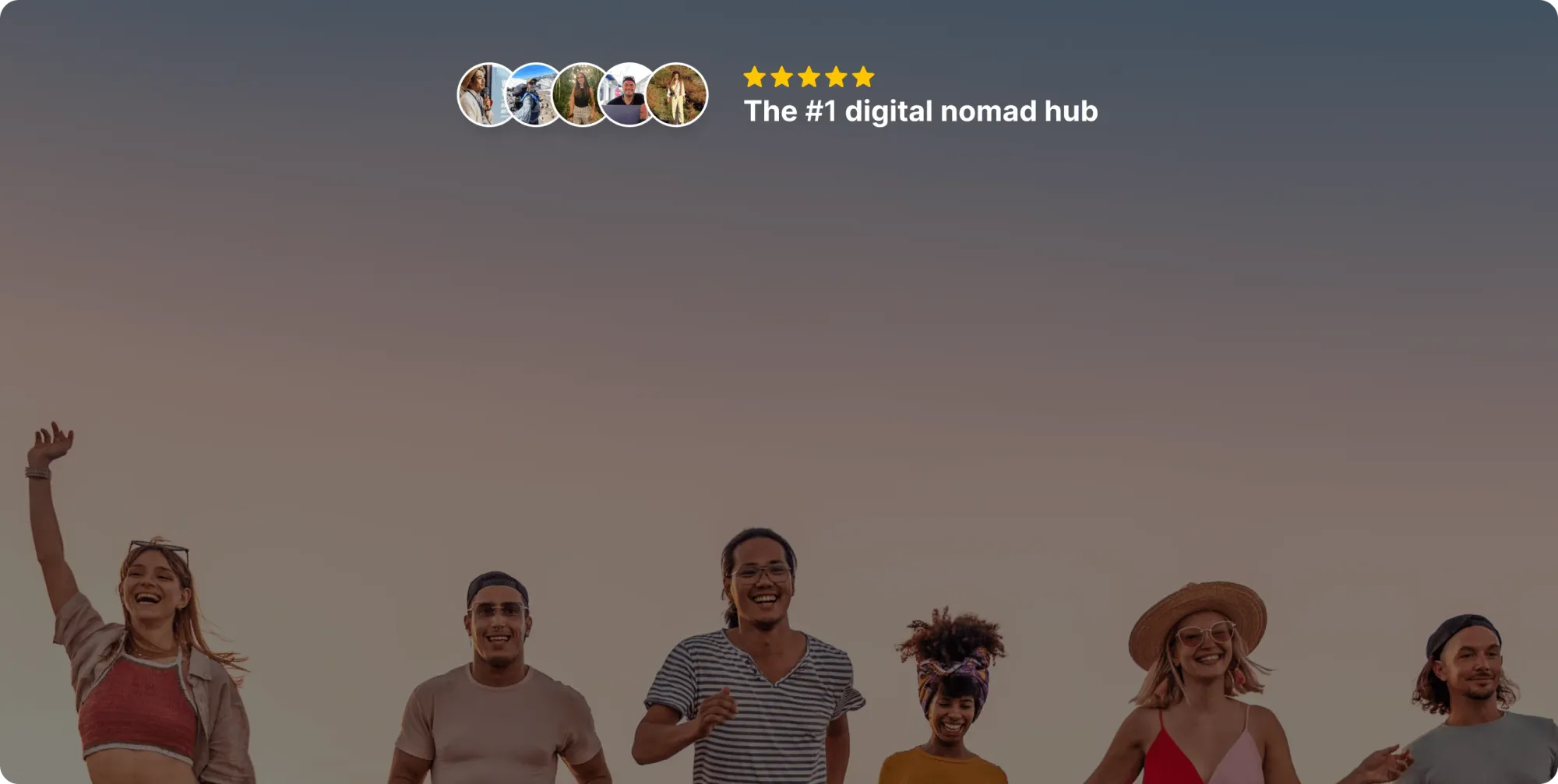The Ultimate Guide to Digital Nomad Visas

Digital nomad visas are an incredible opportunity to live and travel the world legally while making money working remotely.
Becoming a digital nomad opens the door to living in some truly incredible places. And the best part? It’s more accessible than ever, with many countries launching new digital nomad visas and remote work permits every year.
In this guide, we’ll be sharing everything you need to know about digital nomad visas, including what they are, what they require, where you can apply and which countries offer digital nomad visas right now. So, make sure to read until the end to learn more.
What is a Digital Nomad Visa?
A digital nomad visa is a document that allows someone to live, travel, and work remotely in a foreign country.
They’ve been growing in popularity since (you guessed it) the pandemic with countries looking to increase tourism and boost their economy while offering the 40 million digital nomads worldwide the chance to better experience their culture and country.
How Does a Digital Nomad Visa Work?
Unlike ‘normal’ work visas, digital nomad visas are unique as the applicant’s income source won’t be within the country to which they are applying.
Instead, they might be, for instance, freelancers with clients around the world or remote workers from the US who work for an American company but want to spend an extended period of time abroad.
Every year, there are new digital nomad visa options and, although every government will have its own specifications, most are valid for between 6 months to a year with the opportunity to renew or extend.
The only tricky part is that the majority of digital nomad visas require you to have provable digital nomad income, meaning that you will need to make sure to find remote work for at least a year or two before applying.
Digital Nomad Visa vs Tourist Visa: What’s The Difference?
Digital nomad visas and tourist visas can both be great options for someone wanting to work remotely from a foreign country, but it’s important to understand that they serve two very different purposes.
| Digital Nomad Visa | Tourist Visa |
|---|---|
| Takes months to get processed | Takes a couple of weeks |
| It's issued for longer than 90 days | It's usually valid for 30 days |
| It allows you to travel and work | It allows you only to travel |
| You have to be employed to get this visa | You don't have to be employed |
| Designed for remote workers and freelancers | Designed for tourists wanting to visit for leisure |
| Perfect for longer-term stays | Perfect for short-term visits |
| For experiencing new places without pausing business/jobs | For vacations, backpacking, or visiting friends |
What Documents Are Usually Required?
It goes without saying that there is no definitive list of requirements to cover all digital nomad visas around the world besides a valid passport. however generally speaking, most countries ask for the same sorts of things. Let’s break them down:
Application Fees
Some countries require no fees at all but most will set you back at least a few hundred dollars that will need to be paid at the embassy or online.
Proof of Income
You’ll have to prove that you meet the minimum income requirement as a digital nomad as part of the application process. This usually takes the form of bank statements, employment contracts, or tax certificates.
Health and Travel Insurance
Almost all countries offering a digital nomad visa also require you to get health coverage or travel insurance to cover the duration of your stay. Don’t forget to factor this cost into your digital nomad budget.
You might also be required to provide a few additional documents depending on the country you are applying to. Keep an eye out for the following requirements:
- A clean criminal record
- Proof of expertise/education, such as certificates or diplomas
- Evidence of your work as a digital nomad
- A passport-sized ID photo
How to Get a Digital Nomad Visa: The Application Process
Each digital nomad visa has its own process, but generally speaking you can apply for a digital nomad visa by following the application process below:
Step 1: Complete the Application Form
Start by filling out the application form according to the country’s requirements. Some governments provide a fully online system, while others may ask you to download the form, print it, and sign it by hand. Make sure all your details are accurate and up to date—mistakes or missing information can delay your approval.
Step 2: Book an Appointment With the Embassy or Consulate
Once your form is ready, find the appropriate visa office (usually an embassy or consulate) and book an appointment. In some cases, if your country doesn’t host that embassy, you might have to travel to a neighboring country. During your appointment, you’ll often be asked to present your documents and, in many cases, attend a short interview.
Step 3: Collect and Prepare Supporting Documents
Before your appointment, gather all the required documents, such as proof of income, health insurance, a clean criminal record, and accommodation details. Certain documents might need translation into the official language of the country or certification with an apostille. Preparing these ahead of time saves stress later.
Step 4: Submit Your Application and Pay the Fees
With everything in hand, submit your application at your appointment. You’ll usually be asked to pay a visa fee either in advance (and bring the receipt) or directly at the embassy. Be ready for a short interview and, in some cases, biometric data collection like fingerprints. After submission, it’s just a matter of waiting for approval.
How Much Money Do You Need To Apply for a Digital Nomad Visa?
The cost of applying for a digital nomad visa is going to vary by country but from the jump, you should expect to pay an application fee as well as provide evidence that you already earn over a certain amount of money as a digital nomad.
In the majority of countries, the visa application fees cost around $100 to $500 for a single applicant and you’ll also have to pay extra fees to bring your spouse or family with you.
There are a handful of destinations, especially those in the Caribbean, where application fees are a little steeper in the $1,000 to $3,000 range whereas some countries like Mauritius waive all fees together.
On top of the actual application fee, you’ll need to be able to prove that you make enough money as a digital nomad or have enough savings to fully financially support yourself in the country you'll be applying for. The exact amount of earnings will change from place to place, but the average minimum income requirements are usually around $2,000 to $4,000 per month or $50,000 a year.
Which Countries Offer a Digital Nomad Visa?
Currently, over 50 countries offer dedicated digital nomad visa programs or similar permits for remote workers and the landscape of digital nomad visas has evolved significantly in the last 5 years or so.
Here is a list of all the countries that currently offer a digital nomad visa:
 Abu Dhabi (UAE)
Abu Dhabi (UAE) Albania
Albania Andorra
Andorra Anguilla
Anguilla Antigua and Barbuda
Antigua and Barbuda Argentina
Argentina Armenia
Armenia Aruba
Aruba Bahamas
Bahamas Barbados
Barbados Belize
Belize Brazil
Brazil Bulgaria
Bulgaria Cabo Verde
Cabo Verde Canada*
Canada* Colombia
Colombia Costa Rica
Costa Rica Croatia
Croatia Curaçao
Curaçao Cyprus
Cyprus Czechia
Czechia Dominica
Dominica Dubai (UAE)
Dubai (UAE) Ecuador
Ecuador Estonia
Estonia Finland*
Finland* France**
France** Georgia
Georgia Germany**
Germany** Greece
Greece Grenada
Grenada Hungary
Hungary Iceland
Iceland India
India Nepal*
Nepal* Moldova*
Moldova* Slovenia*
Slovenia*
 El Salvador
El Salvador Indonesia*
Indonesia* Ireland*
Ireland* Italy
Italy Japan
Japan Kazakhstan
Kazakhstan Kenya
Kenya Kyrgyzstan
Kyrgyzstan Latvia
Latvia Malaysia
Malaysia Malta
Malta Mauritius
Mauritius Mexico
Mexico Montenegro
Montenegro Montserrat
Montserrat Namibia
Namibia Netherlands**
Netherlands** New Zealand*
New Zealand* Norway
Norway Panama
Panama Peru
Peru Philippines
Philippines Portugal
Portugal Romania
Romania Saint Lucia
Saint Lucia Seychelles
Seychelles South Africa
South Africa South Korea
South Korea Spain
Spain Sri Lanka
Sri Lanka Taiwan
Taiwan Thailand
Thailand Turkey
Turkey Uruguay
Uruguay
* Proper Digital Nomad Visa currently being discussed
** Self-employment, freelance, or passive income visa functioning as Digital Nomad Visa
Frequently Asked Questions About Digital Nomad Visas
Applying for a digital nomad visa can seem overwhelming when you’re first starting the process. To help you get your head around the process, below you can find some of the most frequently asked questions regarding digital nomad and remote work visa options.
Do you have to pay taxes on a digital nomad visa?
Knowing how to pay your taxes as a digital nomad will depend on the country you are applying to and how long you plan to stay there. In some cases, foreign-sourced income can be exempt from tax but you should always check directly with the local foreign ministry for up-to-date information.
Can you bring your family on a digital nomad visa?
With many (but not all) digital nomad visas, yes, family or dependents can be included. This usually involves paying additional fees and providing proof of a higher minimum income.
Does a digital nomad visa lead to citizenship?
Certain countries like Finland, France, and Italy all offer pathways to citizenship via their digital nomad visas by residing in the country for a certain number of years. However, you should always make sure to check the specifics of your program to know if this could be an option.
How do I prove my income with a digital nomad visa?
Proof of income could take the form of tax certificates, bank statements, or employment contracts. We recommend, though, to double-check the specific requirements of the country you are applying to know the exact documents that they accept.
Is getting a digital nomad visa hard?
As long as you meet the eligibility criteria and have your documents in order, then the process should be relatively straightforward, but in some places, factors like nationality, income, and dependents can make it a little more complicated.
What is the easiest country to get a digital nomad visa?
There's no 'one size fits all' country, but destinations like Croatia, Uruguay, and Malaysia have some of the lowest fees and minimum income requirements. You can also submit your application and documents for all three online.
Are digital nomad visas worth it?
If you're a remote worker who wants to experience the world and make money at the same time, then there's no better option than a digital nomad visa. They open the door to living just about anywhere you can dream of while making money and furthering your career at the same time.
Ready to Legally Work and Live Abroad With a Digital Nomad Visa?

Join our global
digital nomad community
Join us for free
Freaking Nomads is supported by you. Clicking through our links may earn us a small affiliate commission, and that's what allows us to keep producing free, helpful content. Learn more





 Travel tips, hacks, and news
Travel tips, hacks, and news Exclusive travel discounts
Exclusive travel discounts Offers and promotions
Offers and promotions Digital nomad inspiration
Digital nomad inspiration Latest articles form our blog
Latest articles form our blog